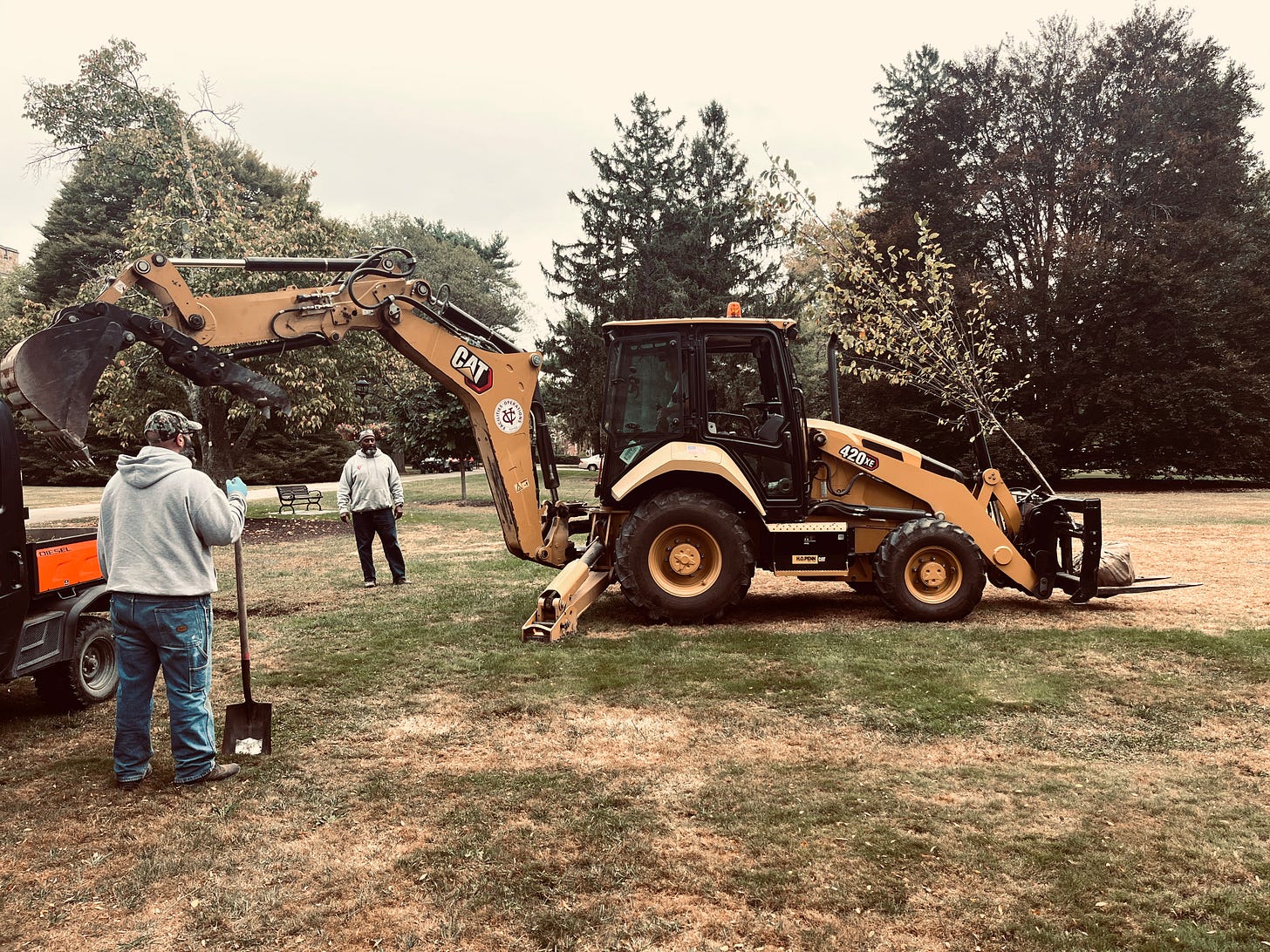I was rushing over to my office this morning—the sky above dull, overcast, and the air slightly chilly—when I saw a tree being planted on campus. An elm tree, a gift of the Class of 2005 (that was the year I joined Vassar! but also, a question: did the original tree die?). I snapped a picture because trees and climate change are subjects that my students and I have been discussing in our Nature Writing class. In his book The Heat Will Kill You First, Jeff Goodell writes that “trees are the superheroes of the climate fight.” Not just because they inhale carbon dioxide and exhale oxygen but also because of the shade they provide. Trees cool off cities. Here’s Goodell: “During the summer of 2022, one researcher found out that on a hot afternoon the temperature on the ground in front of the Paris Opera House measured 133 degrees. A few steps away, under the shade of the trees on Boulevard des Italiens, the temperature on the sidewalk was only 82 degrees.” All of us have all this knowledge inside us in some vague way; the benefit of reading the books in our course is that we access more concrete, and often startling, information. Trees aren’t a simple answer to urban heat, Goodell notes. “For one things, it’s must easier to plant a tree than to keep it alive.” Tree-planting offers good photo-ops; it’s a different story, however, when it comes to maintenance. Goodell writes, “In Los Angeles, city officials estimate that it costs $4,351.12 to plant and maintain a single oak tree for five years.” (I know a bit about the perils of maintaining trees. Last Spring, I planted two small peach trees. One of them has now become leafless and dry. I don’t know why. No dogs peed on it nor did the city pour concrete or asphalt over its roots! No lovers carved their names on the bark nor did any drunk driver hit my tree. These are the dangers, according to Goodell, that our urban trees face.) One wonderful initiative mentioned in The Heat Will Kill You First is Which Plant Where in Australia that helps people select plants suitable for the environs they are living in—including recommendations for plants that will survive in the conditions that await us in, say, 2040. Goodell’s book often makes for difficult reading because it is bringing news from the future. During a drought in 2011, nearly six million trees died over a few months in Texas alone! Goodell writes: “A recent analysis of the Global Urban Tree Inventory, a database that contains 4,734 urban trees in 164 cities, suggests that in a midrange climate warming scenario, three-quarters of urban trees are likely to die from a combination of heat and drought by 2050.” That is just a quarter century from now. I wish that this young elm tree that I saw being planted today grows tall and strong and survives long into the future.
P.S. One more pitch for the Goodell book. I read in its pages that with the discovery of air-conditioning in the last century, and its popular mid-century adoption in large parts of the United States, a lot of retirees from the North began to move to places like Florida and other Southern states. They were flocking to air-conditioned condos on beaches and golf courses. (Other things also happened: corporations moved their headquarters south, factories and manufacturing plants followed, profiting from cheap real estate and non-union labor.) Goodell writes: “The political ramifications of the demographic shift to the Sun Belt was enormous. The flood of conservative retirees to the South, once a Democratic stronghold, shifted the balance of power in American politics. Between 1940 and 1980, warm-climate states in the South gained twenty-nine electoral college votes, while the colder states of the North-east and the Rust Belt lost thirty-one. Among the first to figure this out was Richard Nixon, who wooed these Sun Belt conservatives in the 1960s with anti-civil rights messages and racial dog whistles. American politics have never been the same since.” Air-conditioning made a hole not only in the ozone layer but the fabric of our democracy!




Once cut, twice a hole. :(
Sorrowful reading.